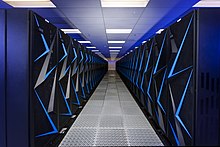IBM Power Systems
Power Systems è una famiglia di server prodotti da IBM e basati sui suoi processori Power. È stata creata nel 2008 come fusione delle linee di prodotti System p e System i.

Storia modifica
All'inizio degli anni 90, IBM disponeva di due distinte linee hardware basate su POWER e PowerPC:
- Server con processori con architettura IBM PowerPC-AS nella famiglia AS/400 (in seguito noto come iSeries, poi System i) che eseguono OS/400 (in seguito noto come i5/OS e ora IBM i)
- Server e workstation che utilizzano processori POWER e PowerPC della famiglia RS/6000 (in seguito nota come pSeries, quindi System p), che eseguono IBM AIX e PowerLinux.
Dopo l'introduzione del processore POWER4 nel 2001, c'era ormai poca differenza tra l'hardware "p" e "i", infatti le uniche differenze erano sostanzialmente nelle offerte di software e servizi. Con l'introduzione del processore POWER5 nel 2004, anche la numerazione dei prodotti è stata sincronizzata. Il System i5 570 era praticamente identico al System p5 570.
Nell'aprile 2008, IBM ha ufficialmente unito le due linee di server e workstation con lo stesso nome, Power,[1] e successivamente Power Systems, con hardware identico e una scelta di sistemi operativi, software e contratti di servizio,[2] basati in precedenza su un'architettura POWER6. La linea PowerPC è stata quindi interrotta.
Modelli modifica
Modelli IBM Power Systems:
- 2008/2009
- BladeCenter JS12 Express
- BladeCenter JS22 Express
- BladeCenter JS23 Express
- BladeCenter JS43 Express
- Power 520 Express
- Power 550 Express
- Power 560 Express
- Power 570
- Power 575
- Power 595
- 2010
- BladeCenter PS700 Express
- BladeCenter PS701 Express
- BladeCenter PS702 Express
- Power 710 Express
- Power 720 Express (8202-E4B, 8202-E4C) (CPU POWER7 a 4, 6 o 8 core) [3][4]
- Power 730 Express
- Power 740 Express (8205-E6B, 8205-E6C) (1~2 CPU POWER7 a 4, 6 o 8 core) [3][4]
- Power 750 Express (8233-E8B) (CPU POWER7 1~4 6 o 8 core) [5]
- Power 755 (8236-E8C) (4 CPU POWER7 a 8 core) – per il calcolo ad alte prestazioni (HPC)[5]
- Power 770
- Power 780
- Power 795
- 2011
- Power 775 – noto anche come PERCS
- 2012
- Flex System p260
- Flex System p460
- Flex System p24L (solo Linux)
- 2013
- 2014
- Power Systems S821LC e S821LC
- Power Systems S822 e S822L
- Power Systems S814
- Power Systems S824 e S824L
- Power Systems E870
- Power Systems E880
- 2015
- Power Systems E850
- Power Systems S812L e S812LC
- Power Systems S822LC
- 2017
- Power Systems AC922
- Power Systems L922
- Power Systems S914
- Power Systems S922
- Power Systems S924
- Power Systems H922
- Power Systems H924
- Power Systems E950
- Power Systems E980
IBM PowerVM fornisce la soluzione di virtualizzazione per i server Power Systems.
Note modifica
- ^ (EN) IBM: i + p = Power, su CNET, 3 aprile 2008. URL consultato il 12 dicembre 2020.
- ^ (EN) Introducing the New Power Equation from IBM, su www-03.ibm.com, 2 aprile 2008 (archiviato dall'url originale il 5 aprile 2008).
- ^ a b (EN) IBM Power 720 and 740 (PDF), su IBM Redbooks. URL consultato il 13 maggio 2021.
- ^ a b (EN) IBM Power 720 and 740 Technical Overview and Introduction (PDF), su IBM Redbooks. URL consultato il 3 giugno 2021.
- ^ a b (EN) IBM Power 750 and 755 Technical Overview and Introduction (PDF), su IBM Redbooks. URL consultato il 2 giugno 2021.
- ^ a b (EN) IBM Power 720 and 740 Technical Overview and Introduction (PDF), su IBM Redbooks. URL consultato il 3 giugno 2021.
- ^ a b (EN) IBM Power 750 and 760 Technical Overview and Introduction (PDF), su IBM Redbooks. URL consultato il 3 giugno 2021.
Altri progetti modifica
- Wikimedia Commons contiene immagini o altri file su IBM Power Systems
Collegamenti esterni modifica
- (JA) Sito ufficiale, su ibm.com.
- (EN) Sito ufficiale, su ibm.com.
- Redbook IBM Power Systems
- Pagina Web dell'infrastruttura IT IBM
- Rivista IBM Systems Power Systems